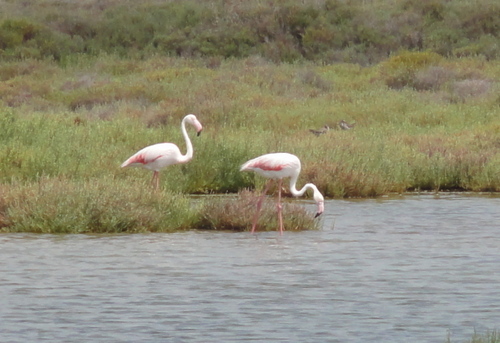We took advantage of a coll and cloudy start to drive north to St Carles de la Rapita, a holiday resort with well cared for sandy beaches on the south side of the Delta del Ebre, so Clare could enjoy a comfortable swim. We then set out on the southernmost road across the Delta, dead straight, flanked by huge fields of rice, as far as the eye could see, with a variety of interesting looking dwellings. The road runs right out to a huge sand bar, ten miles long, a quarter of a mile wide, giving vast sandy Mediterranean beaches on the east side and more interesting saline wetlands on the west side.
The sand bar links several islands and vast areas of salt ponds which are still in production. The enclosed lagoon is an in-shore fishery harvesting fish and crustaceans. The bird life is extraordinarily rich and the entire region has a series of conservation areas of great interest, because of the unique mix of salt-water and fresh water ecosystems, insect and bird life. Whenever I stopped to take a picture by an irrigation canal I saw several species of dragonfly, not just one. I just missed a photo of the beautiful elegant black winged Stilt in a roadside pond, but snapped a couple of Egrets (one walking across the road), some Flamingos and a little Stint, wandering around a muddy pool calling out for its partner. Such a treat.
Not far from the sand bar is a new Tancada lake wetland conservation area and interpretation centre. An old area of salinas has been reclaimed and is now managed to encourage the unique bird life which flourishes in this seemingly unpromising environment. By the time we got there the sun was high, it was nearly lunchtime and it wasn't worth paying the €7 entrance fee for just a short wander, so we resolved to return another day, and went for lunch at the excellent Terrassela de Saur restaurant in Poblenou del Delta, a few miles away. Here we had great fun deciphering a menu written in Catalan, before the English translation was produced.
This small village seems to have taken its present shape in the past forty years. It has a modern church and simple low rise buildings in modern materials, sympathetically laid out. There were plenty of guest houses and places to eat, but we couldn't see any kind of shop. The streets were remarkably free of advertising hoardings of any description - such a simple aesthetic pleasure. It may have expanded chiefly to meet the needs of visitors. If so, a very good job was done. its simple delights (including Catalan cuisine) advertise themselves.
This small village seems to have taken its present shape in the past forty years. It has a modern church and simple low rise buildings in modern materials, sympathetically laid out. There were plenty of guest houses and places to eat, but we couldn't see any kind of shop. The streets were remarkably free of advertising hoardings of any description - such a simple aesthetic pleasure. It may have expanded chiefly to meet the needs of visitors. If so, a very good job was done. its simple delights (including Catalan cuisine) advertise themselves.
































